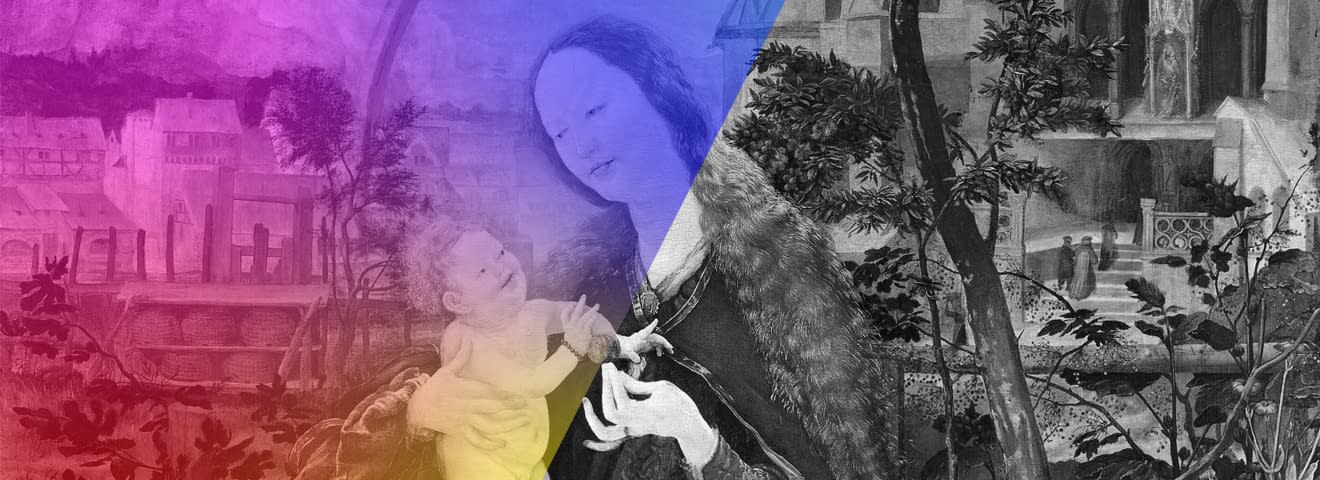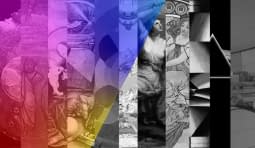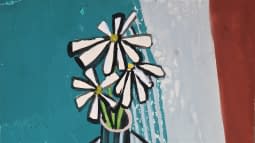Rainbow #3 - From the Late Middle Ages to the Early Renaissance
The Rainbow and its Reference to the Old Testament
So we continue to travel through space and time, following the light traces of the rainbow. More precisely, we travel back to the time of the late Middle Ages and the early Renaissance. For here the meaning of the rainbow slowly detached itself from the Old Testament story of the Flood and gained presence in new contexts as a symbolically charged motif. For example, the rainbow appeared in depictions of Christ as Pantocrator. This type of image replaced the Maiestas Domini representations in the 13th and 14th centuries. The mandorla, typical of the Maiestas Domini, with Christ enthroned on the rainbow as the central element, was adopted in the Pantocrator representations. The mandorla is an almond-shaped shield of divine light that surrounds Christ. In the context of these depictions, the Flood, upon which the rainbow appeared in the Old Testament, serves as a prefiguration to the coming, final judgment of the world. By combining the mandorla with rainbows, the iconography of the two elements became fluid and the sharp boundaries dissolved, so that the mandorla now appeared in rainbow colours. The variety with which the divine light could be represented also seemed particularly enticing to the artists of the early Renaissance. For the rainbow encompasses the entire spectrum of divine light, which, according to the Christian faith, surrounds everything and penetrates us. Yet the individual colours are also brought together in it in a reconciliatory way. This also alludes to the light that is to appear after the Last Judgment. So what pictorial topics and works in the transitional phase from the late Middle Ages/late Gothic to the Renaissance do we know? We will explore the broad interpretation of the theme with the help of some remarkable examples.
Christ on the Rainbow Throne
An excellent example of the motif of Christ as the ruler of the world is the major work of the old Italian master and pioneer of the Italian Rinascimento, the Renaissance, Giotto di Bondone (1267 or 1276 to 1337).
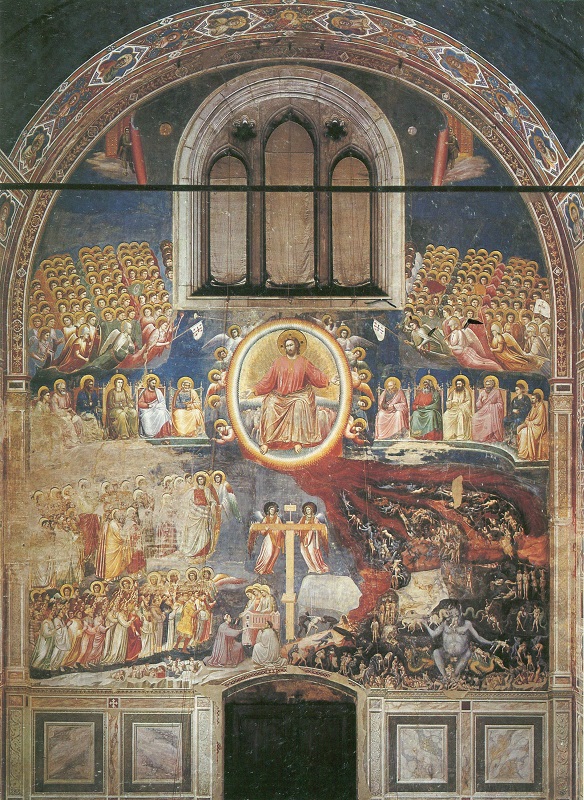
The fresco on the west wall of the Arena Chapel depicts the Last Judgment with Christ as the world's judge enthroned on a rainbow, surrounded by a dazzling rainbow mandorla, which is even more nuanced in colour than the gradient of the rainbow throne itself. Giotto painted the walls of the Cappella degli Scrovegni in Padua between 1304 and 1306. The pictorial field below Christ is divided by the cross into good on the left and evil on the right, the blessed and the damned, paradise and hell, and is held by the archangels Michael and Raphael. The horizontal is formed by the enthroned apostles on either side of the mandorla, above which the heavenly hosts descend. The old sky and the heavenly bodies are rolled in from the vaulting of the barrel vault. While the top represents the order, the bottom shows the chaos. In his mosaic-like feathered mandorla, the enthroned Christ performs the gesture of rejection and reception. Through the divine light, emphasised by the incidence of light from the window above, the boundaries of God who became human in Christ are thus blurred. The rainbow light of God surrounding Christ serves as a reminder of the covenant. It reminds God to keep the promise after the Flood and to tame his power.
Naturalistic Depiction of the Rainbow
Giotto is known for his then new style of painting, which depicted people and nature in an unusually naturalistic way. This detachment from the strict Byzantine pictorial language was preceded by gentle advances as early as the Romanesque period, which slowly paved the way for pure landscape paintings. The prosperity of Italy at this time also influenced the commissions. While commissioners continued to desire works with religious motifs, these were now paired with secular preferences. Future generations of artists - inspired by Giotto - were to be even more intensively occupied with the more precise reproduction of nature. But the change towards this more naturalistic approach can already be observed in the Arena Chapel. The colours of the rainbow merge imperceptibly into one another. Thus, the fresco is considered one of the first representations in which the colours are not only depicted as discreet stripes, but are reproduced in the mandorla arch almost true to nature, from reddish to orange to bluish. Only in the centre is an additional white stripe visible, which gently blends with the other colours. This reveals the painterly, i.e. artificial, rendering tradition, as the rainbow was not reproduced entirely realistically. It is unclear how closely Giotto studied the rainbow and how important the lifelike rendering was to him, although his interest in natural science is well known. The artificiality is further emphasised by the absence of light and shadow throughout the fresco. Christ acts as the source of light, which consequently also creates the rainbow. The colourful mandorla represents a shield from which a jet of fire spews into hell. The flames, which are divided into four streams of fire, sweep the damned along with them, towards the devils. The rainbow is thus on the one hand a divine shield of the saved and at the same time hostage of the damned. Thus, the fresco symbolises that the divine is immanent in everything.
The Rainbow in the Marian Devotion
A motivic peculiarity in the 13th and 14th centuries, especially in mysticism, is the connection of the rainbow and the veneration of Mary. The reference to the judgment dissolved here. Mary served as a refuge for sinners, just as the ark was a safe haven for the elected. Thus, whoever joins the Church of Mary finds salvation. Bonaventure wrote (1221-1274):
But there is a blue colour in the rainbow, which corresponds to the essence of virginity, and also a reddish one, which marks the appearance of love; the watery one points to the monument of Your purity and humility, which God has chosen in You. You are recognised as a rainbow in the clouds of heaven, shining upon us, giving examples of morality to all the wretched. You put an end to all heresies and destroy the heretics, in Christ, since You bring both natures together at the same time. Invincible rainbow, mighty rainbow, strong rainbow, sweet, lovely rainbow. Bow, which is open to the gates of heaven. (Behling, p. 14, translated from German to English by YR)
However, pictorial representations of these interpretations are rare. The "Stuppach Madonna" by Matthias Grünewald (1519), in which the rainbow in the background embraces the head of Mary, is considered a late and probably the best-known work of this genre.
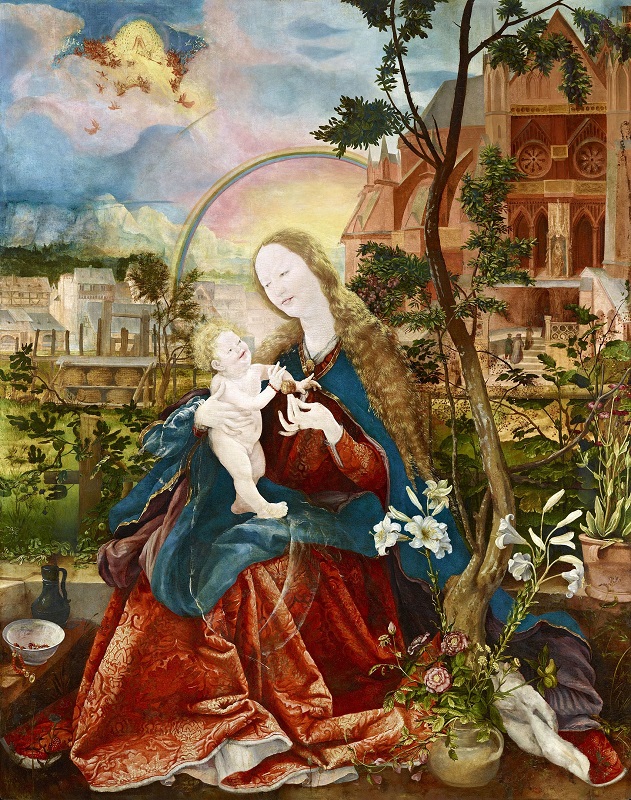
The Annunciation Is Charged with Symbolism
The rainbow, however, also appears in Annunciation scenes. The Northern Renaissance in particular, likewise influenced by its prosperity, attempted to pepper works of art with countless symbols from the Bible. This is also the case in the Annunciation by Jan Van Eyck (1390 to 1441). Here, the richly dressed and adorned archangel Gabriel appears before Mary with matching, colourful wings.
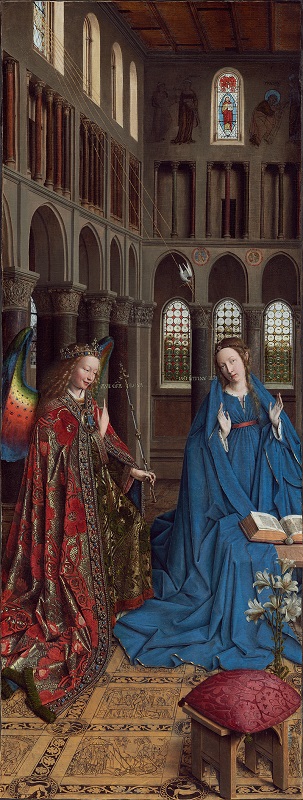
The Flemish old master created the oil painting, probably once the left wing of a triptych, between 1434 and 1436. The biblically important event with the beginning of Christ's human life and the incarnation of the Saviour, in combination with the rainbow, points to the redemption of mankind through his death and resurrection. Great symbolic significance is attributed to the divine light throughout the work. Seven rays sweep down on Mary through a window, preceded by the dove of the Holy Spirit. The rainbow also has seven colour gradients. Seven is in many ways an important number in Christian numerology. Here, in the context of the Holy Spirit, it connects the Old Testament with the New. In the Old Testament it symbolises perfection and the beginning of the creation story. In the New Testament it is the Seven Gifts and in Revelation the Book Scroll with the Seven Seals, which contains the divine provisions for the end of the world. The rainbow wings are additionally decorated with peacock feathers, a symbol of paradise and immortality. They thus refer to the resurrection, renewal and the Last Judgment. This combination of rainbow and peacock feathers is a novelty in Annunciation scenes. On the one hand, it also refers to God's covenant in the Genesis, as well as John 4:3, with Christ who will judge on his rainbow throne and purify the earth in the end. You can read more about this in the 2nd Rainbow Blog.
Thus, the Old Testament is linked with the New and the role of Christ as Saviour is doubled. Gabriel's wings also refer to his role as intercessor for the world at the time of the Flood. Van Eyck thereby makes the archangel a symbol both of the beginning (alpha) of the New Testament and Christ's ministry, for he is the herald of his prophesied birth, and of the end (omega) of the New Testament, Christ's earthly ministry and his role as judge on the Last Day. This means that the coloured wings emphasise his future role and announce his resurrection and return.
Another Italian Master and the Annunciation
A well-known fresco by Fra Angelico (1395 to 1455), early Renaissance painter, located in the north corridor of San Marco in Florence as part of a fresco cycle, also poetically depicts the Annunciation to Mary (c. 1450). Here, too, the colourful gradients of the angels' wings are remarkable.
_800pix.jpg)
They symbolise and embody at the same time the "radiance of the divine light that shines into the image" (Gottlob 2002, 231, translated from German to English by YR). The angel as messenger from heaven brings the light to earth and gives insight into this divine, which from now on also surrounds Mary and Christ. Here, too, the architecture has a supporting effect on various levels. Among other things, the midday incidence of light from the window in the corridor, where the fresco is located, illuminates it precisely from this direction - namely at the point in the fresco where the divine light comes from. The mysterious outside thus becomes visible and doubled by the light in the picture, but can never be completely revealed, because the view is immediately hidden again by the materiality of the colour.
The colour "points to the unimaginable, unrepresentable event that signifies both the beginning and the end of history" (Gottlob 2002, 232, translated from German to English by YR). What we catch of the mystery is immediately withdrawn from us, it is a back and forth between form and formless (cf. Gottlob 2002, 212). The angel is thus a transitional threshold. Accordingly, he is located twice with his wings close to the edge, pictorially between the interior of the portico and the exterior in the picture itself, but also physically between the picture field and the masonry on which the fresco was applied. Thus, the mystery withdraws itself from us again, stimulating the imagination and meditation.
The wings present the entire colour palette that appears in the painting itself, except for the black and blue colour of Mary's robe. The formlessness of the pure colour stimulates this contemplation. The "Immaculate Conception" of Mary itself, like the Annunciation scene, represents the mysterious, the present and the absent of the Divine in these moments. As do the rainbow-coloured wings of Gabriel. The work as a whole embodies the "mystery of the incarnation, in which the Word of God becomes flesh." (Gottlob 2002, 208, translated from German to English by YR) All these demarcations point to the "border between the lost paradise and the earth" (Gottlob 202, 215, translated from German to English by YR). The fine application of paint in the fresco emphasises these boundaries and makes the angels' wings appear as traces of the divine. The act of painting thus functions here between word and visualisation. In the context of Christian faith, this expresses love, but also desire and sorrow, as well as the vulnerability that oscillates between creation and emptiness and symbolises faith.
What Happens Next with the Rainbow?
The colour gradient of the rainbow was used in a variety of ways. From the Renaissance on, the mandorla in the pantocrator motif was sometimes omitted altogether, so that the representation of the divine covenant was now dominated by the scene of the thanksgiving sacrifice. This is the case, for example, in the ceiling fresco of Michelangelo's Sistine Chapel (1508-1512). The knowledge of the relationship and the connection of these events had not disappeared with it, however. Furthermore, the rainbow became more and more a sign of salvation of "God with us". The symbol and this meaning could therefore also be applied to a range of other topics as a typological stimulus, for example in topics such as the "salvation of the Jews in their passage through the Red Sea". But you'll learn more about that in upcoming blogs.
Glossary:
Pantocrator: The word comes from the Greek and means "ruler of the world" or "universal ruler". From the 4th century onwards, the name was used as a "synonym" for Jesus Christ. Before that, the term was used for God the Father. Accordingly, there is a typological representation of Christ as Pantocrator in art history, where he is depicted as an icon.
Mandorla: From the Italian for "almond". Halo/aureole in the shape of an almond surrounding the figure. It is especially found in representations glorifying Christ or Mary.
Majestas Domini: Representation in which Christ is depicted frontally. He is usually seated on his (rainbow) throne, surrounded by a mandorla, as well as by the four evangelist symbols (tetramorph).
Prefiguration: In the interpretative tradition of the Bible, prefiguration (also typology) means relating/referencing a person or a story from the Old Testament (typos) with a person or story from the New Testament (antitypos). The preceding story thus foreshadows the following story and thus establishes a tradition that creates legitimacy and continuity through this historical reference.
Last Judgement: The Jewish-Christian tradition of the imminent end of the world. According to this, God judges people's deeds, after which they either go to the heavenly paradise or to the eternal damnation of hell.
Rinascimento: The Italian term for the Renaissance, a movement in art and intellectual history that originated in Italy and involved a revival of ancient art and philosophies. The epoch lasted approximately from 1400 to 1620 ( Early to Late Renaissance).
Further literature:
Amott, David, Dr. Peacock, Martha. (21.01.2014). A Symbolic Study of Van Eyck’s Annunciation, in: Journal of Undergraduate Research, http://jur.byu.edu/?p=8373 (20.04.2023).
Gottlob. (2002). Stimme und Blick. Zwischen Aufschub des Todes und Zeichen der Hingabe: Hölderlin - Carpaccio - Heiner Müller - Fra Angelico. Bielefeld: Transcript.
Hand, John Oliver, Yakush, Mary, Wolff, Martha Wolff. (1986). Early Netherlandish Painting. Washington: National Gallery of Art.
Lange, H. (2023). Giotto’s Painted Reliefs, in: Giotto's Arena Chapel and the Triumph of Humility, Cambridge: Cambridge University Press, S. 110-174.
Lee, Raymond L. und Fraser, Alistair B. (2001). The Rainbow Bridge: Rainbows in Art, Myth and Science. University Park. The Pennsylvania State University Press. 2001.
Miller, J. I. (1985). Symbolic Light in Giotto and the Early Quattrocento in Florence, in: Notes in the History of Art, 5(1), S. 7–13.
Regenbögen für eine bessere Welt. (1977). Trilogie 3. Stuttgart: Württembergischer Kunstverein.
Ward, J. L. (1975). Hidden Symbolism in Jan van Eyck’s Annunciations. The Art Bulletin, 57(2), S. 196–220.
